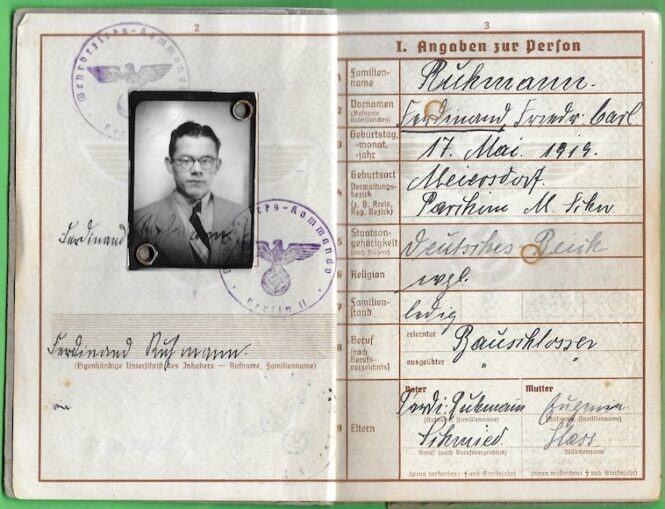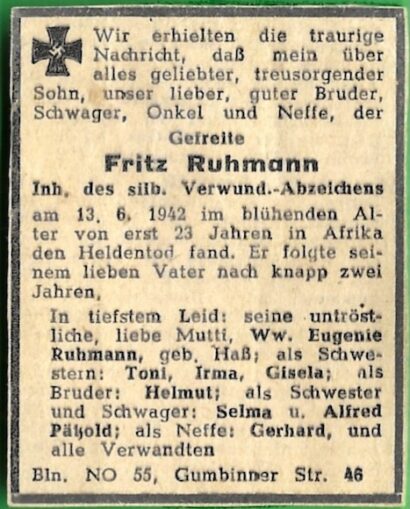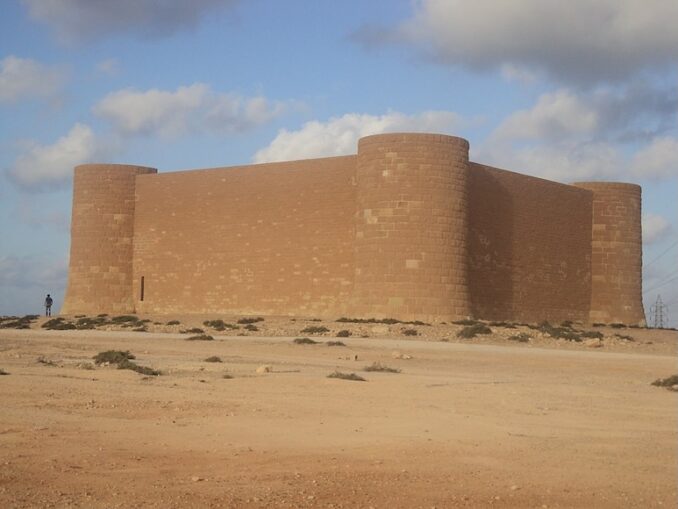In WW2, a Wehrpass contained the personal and service information of a Wehrmacht volunteer or conscript and was used for identification and recording purposes. Issued when registered for military service, it was kept by the volunteer or conscript until their induction into the Wehrmacht.
When they had recruited into a branch of the Wehrmacht (Heer, Kriegsmarine, Luftwaffe or Waffen SS), their Wehrpass was exchanged for a Soldbuch (a less-detailed identification book physically carried by active service personnel). The Wehrpass was then deposited at their unit’s headquarters, where it was updated to reflect further military service, campaigns, promotions and awards.
There are three versions of Wehrpässe predominately differentiated by the cover although the contents also had further variations. The early version cover (1934-1938) has a Heer style eagle with downward wings and gothic script on the grey cover. The version issued during WW2 (1938-1945) has outstretched eagle’s wings and gothic script. A variant used from 1942-1945 also has outstretched eagle’s wings but with plain printed script.
The cover may also have been ink stamped or hand written to show which branch of the Wehrmacht, the volunteer or conscript had been assigned to and at the top right corner, a box into which the initial of the family name of the volunteer or conscript were sometimes written to aid filing.
The Wehrpass was returned to the Wehrmacht volunteer or conscript on retirement from the Wehrmacht or, if killed in action, returned to his family via the original recruiting office.

© John Tull 2025, Going Postal
In my collection I have the Wehrpass of Ferdinand Friedrich Karl Ruhmann, known as Fritz, the son of Ferdinand Ruhmann, a blacksmith, and his wife Eugenie. Born in Meierstorf near Ludwigslust in northern Germany on the 17th of May 1919, before being conscripted into the German army, he was an unmarried building fitter of Gumbinner Strasse in Berlin where he lived with his parents. Within this Wehrpass are also his Wound Badge Certificate and a newspaper cutting of a family notice.
When conscripted on the 14th of July 1938, Fritz was classified as being an Ersatzreserve I (Spare Reserve type 1), who were untrained, had not yet been called up and were under 35 years old, to the Schützen-Ersatz-Kompanie 230.
Called up for duty and sworn in to serve the Deutsches Reich on the 2nd of December 1939, Fritz was assigned to Company 1 of the Schützen-Ersatz-Kompanie 230. Based in Brandenburg an der Havel, this was a motorised infantry replacement unit. His rank was a Schütze, which was Shooter or Rifleman and which originally had meant an Archer, and he wore a size 56 Stahlhelm (steel helmet) and size 42 Stiefel (boots).
There he was trained in the use of the Gewehr 98 bolt-action rifle, the Pistole 08, known as the Luger P08 semi-automatic pistol, Light Machine Guns 08/15 and 34 and the Stielhandgranate 24 (Stick Grenade).
Having completed his basic training and being promoted to Oberschützen, on the 30th of January 1940, Fritz was put on Aktiver Wehrdienst (Active Military Service) and assigned to the Infanterie-Regiment-230 which had been formed on the 26th of August 1939.
From the 1st of February until the 9th of May 1940 he was engaged in the Stellungskämpe, Positional Warfare of the “Phoney War”, between the Moselle and Saar rivers.
On the 10th of May 1940, the “Phoney War” became real and Fritz took part in the one day invasion of Luxembourg during which he was severely wounded by a grenade splinter in his left foot.
This injury, for which he was awarded the Black Wound Badge on the 6th of February 1941, put him in hospital for some time so on the 15th of June 1940, he was assigned back into a Reserve Battalion, the Infanterie-Ersatz-Bataillon 230.
He remained in Reserve until the 26th of May 1941 when, presumably recovered from his wound, he was assigned to the Kradschützen-Ersatz-Bataillon (Motorcycle Rifle Replacement Battalion) that had been formed on the 20th of November 1940 in the Hohenfriedberg barracks in Bad Freienwalde.

© John Tull 2025, Going Postal
Fritz remained with this unit until the 3rd of October 1941 when he reassigned to the Deutsches Afrika Korps, specifically the Feld-Ersatz-Bataillon 21 (Field Replacement Battalion) of the 21st Panzer Division.
On arrival, according to his service record, he took part in the Belagerung von Tobruk (Siege of Tobruk) until the 28th of October when he was reassigned to the Pionier-Bataillon (motorisiert) 900 of the Panzergruppe Afrika.
Pioneer Battalions were Combat Engineers called on to perform engineering and construction tasks as well as undertaking a fighting role usually with anti-tank rifles and guns, and flamethrowers.
On the 5th of September 1941, this battalion had requested 23 replacement men which would have included Fritz as a transfer from his Reserve Battalion. On the 13th of November, the battalion demanded a further 33 replacements. Due to the high level of losses, the battalion until mid-December was only made up of the staff and men of Companies 1 and 3. Since no further replacements were available until early 1942, the requirement by the 9th of January 1942 was for a total of 181 replacements.
With the Pionier-Bataillon (motorisiert) 900, according to his service record, Fritz during November and December 1941 took part in battles for Festung Tobruk, retreat battles around Gazala, the retreat to the southern area of Benghazi before at the turn of the year taking up mobile defence in the area south-east of Agedabia. He was also promoted to Gefreiter (Corporal).
In January and February 1942, he took part in the retreat to and defence of Marada-Marsa el Brega and battles around Agheila which preceded him taking part in the reconquest of Cyrenica.
Fritz was awarded the Deutsch-Italienische Erinnerungsmedaille for the campaign in Africa on the 15th of March 1942 and continued to serve with the Pionier-Bataillon (motorisiert) 900.
Rommel launched Unternehmen Venezia (Operation Venice) on the 26th of May to make a flanking manoeuvre south of the fortified “box” at Bir Hakeim with the aim of pushing the British east past Tobruk so as to leave it vulnerable to attack.
The Pionier-Bataillon (motorisiert) 900 specifically took part in fighting around the El-Adem Box as part of the Gazala offensive by the Panzerarmee Afrika. The El-Adem Box was a small area of desert consisting of undulating land, which the British had surrounded with barbed wire and mines to defend the El-Adem road to Tobruk. The British forces around there had been ordered to withdraw into the box to delay the Germans when the need arose.
The Battle for El-Adem commenced on the 27th of May with bombing and strafing by the Luftwaffe as the British 8th Army was retreating en masse back towards Tobruk. Fighting continued through May into June with a series of tank and infantry attacks supported by artillery and the Luftwaffe with the main battles being initially around the Knightsbridge and Bir Hacheim boxes of the Gazala Line. By the 12th of June the British who had retreated into the El-Adem box were surrounded and, in the fighting on the 13th of June, Fritz was severely wounded by grenade splinters in his temple and neck (carotid artery) from which he bled to death.
The battles continued until late June when the British 8th Army under Auchinleck finally withdrew, as Tobruk had fallen on the 21st, leading to the Rommel’s Panzerarmee Afrika pursuing them all the way to Egypt.

© John Tull 2025, Going Postal
The family of Fritz were not informed of his death until the 27th of October 1942 and he was mourned by his mother (his father had died in 1940), sisters Toni, Irma, Gisela and Selma, brother Helmut and nephew Gerhard.
Fritz Ruhmann was initially buried at the Ehrenfriedhof El-Adem. His name is inscribed on the Deutsche Kriegsgräberstätte at Tobruk that, in individual sarcophagi in the crypt below the central courtyard, contains the remains of 6,026 war dead, that were brought together from all of the German cemeteries within Libya in the 1950s.

German World War II memorial in Tobruk, Libya,
Maher27777 – Public domain
© John Tull 2025



